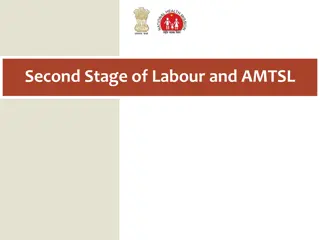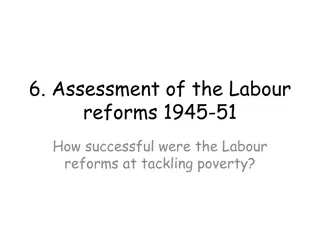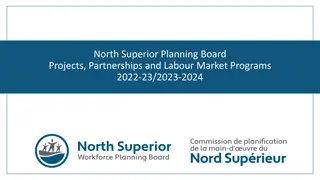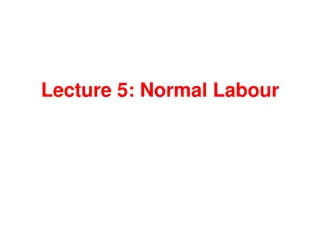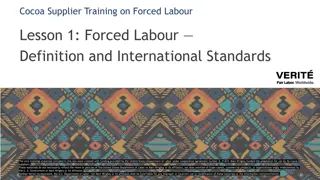Education and Labour Market Insights
This presentation provides valuable insights into the relationship between education and the labour market, discussing topics such as the importance of education for employment, increased chances of employment with more education, higher wages with additional education, growth in employment by sector, and growth in employment by occupation over the years 2001-2012.
Download Presentation

Please find below an Image/Link to download the presentation.
The content on the website is provided AS IS for your information and personal use only. It may not be sold, licensed, or shared on other websites without obtaining consent from the author.If you encounter any issues during the download, it is possible that the publisher has removed the file from their server.
You are allowed to download the files provided on this website for personal or commercial use, subject to the condition that they are used lawfully. All files are the property of their respective owners.
The content on the website is provided AS IS for your information and personal use only. It may not be sold, licensed, or shared on other websites without obtaining consent from the author.
E N D
Presentation Transcript
EDUCATION AND THE LABOUR MARKET Hersheela Narsee and Mamphoku Khuluve Presentation to TVET Colleges June/July 2015 1
WHY IS EDUCATION IMPORTANT FOR THE LABOUR MARKET ? 2
MORE EDUCATION INCREASED CHANCE OF EMPLOYMENT 1.0 0.9 0.8 0.7 Employment probability 0.6 (conditional) 0.5 0.4 0.3 0.2 0.1 0.0 0 1 2 3 4 5 6 7 8 9 10 11 12 13 14 15 Education (years) 3
MORE EDUCATION: HIGHER WAGES 4.0 Log of wage, 2005 (conditional) 3.5 3.0 Log of wage per hour 2.5 (conditional) 2.0 1.5 1.0 0.5 0.0 0 1 2 3 4 5 6 7 8 9 10 11 12 13 14 15 Education (years) 4
GROWTH IN EMPLOYMENT BY SECTOR: 2001-2012 Growth (2001-2012) Employment Shares Share of Change (2001-2012) -28.80% -20.60% -8.20% 21.50% 4.50% 0.40% 16.60% 108.90% 20.60% 11.50% 31.30% 20.10% 11.20% 41.70% 3.80% 100.00% Absolute -719,232* -514,468* -204,764* 537,376* 112,149 10,774 414,453* 2,720,821* 513,572* 288,364* 782,108* 502,841 279,267 1,041,524* 95,253 2,497,763* Relative -2.6 -2.7 -2.2 1.0 0.3 0.5 2.5 1.6 0.9 2.1 2.8 4.2 1.8 2.1 0.4 1.0 2001 15.50% 10.50% 5.00% 21.00% 14.50% 0.80% 5.70% 63.10% 21.90% 4.90% 9.30% 3.60% 5.70% 17.80% 9.20% 100.00% 2012 7.40% 4.80% 2.60% 21.10% 12.70% 0.80% 7.70% 71.50% 21.70% 6.10% 13.30% 6.60% 6.70% 22.20% 8.30% 100.00% Primary Agriculture Mining Secondary Manufacturing Utilities Construction Tertiary Trade Transport Financial Services Business Activities N.E.C Other Community Services Private Households Total 5
GROWTH IN EMPLOYMENT BY SECTOR: 2001-2012 Growth in employment over the past decade was in the following sectors (in order of priority): Community Services (eg. Government) Financial Services (eg. Banking, Insurance) Trade (eg. Wholesale and Retail) Construction Transport In the future, could expect growth in agricultural sector 6
GROWTH IN EMPLOYMENT BY OCCUPATION: 2001-2012 Growth (2001-2012) Employment Shares Share of Change Absolute Relative 2001 2012 (2001-2012) High-Skilled 1,141,326* 2 20.80% 25.30% 45.70% Managers 475,491* 2.7 5.90% 8.30% 19.00% Professionals 665,835* 1.7 14.90% 17.00% 26.70% Medium-Skilled 767,555* 0.6 49.60% 46.10% 30.70% Clerks 300,982* 1.2 9.80% 10.20% 12.10% Service & Sales Workers 627,027* 1.8 12.70% 15.00% 25.10% Skilled agricultural and fishery workers -311,122* -8 3.40% 0.50% -12.50% Craft & Trade Workers 124,687 0.4 13.70% 12.10% 5.00% Operators & Assemblers 25,981 0.1 10.10% 8.40% 1.00% Unskilled 612,716* 0.8 29.40% 28.50% 24.50% Elementary Occupations 517,463* 1 20.10% 20.30% 20.70% Domestic Workers 95,253 0.4 9.20% 8.30% 3.80% Total 2,497,763* 1 100.00% 100.00% 100.00% 7
GROWTH IN EMPLOYMENT BY OCCUPATION: 2001-2012 Growth in employment over the past decade was in the following occupational categories (in order of priority): Professionals Service and Sales workers Elementary occupations Managers 8
CHANGES IN SKILLS SHARES BY SECTOR: 2001-2012 Proportions Change in Prop Change in No 2001-2012 2001 2004 2007 2010 2012 High-Skilled 2.90% 5.40% 4.80% 7.20% 7.60% 4.8 percentage points 27,602 Med-Skilled 54.50% 52.50% 53.10% 35.20% 36.80% -17.7 percentage points -571,229* Primary Unskilled 42.60% 42.10% 42.10% 57.60% 55.50% 12.9 percentage points -175,392* -719,232* Total 100% 100% 100% 100% 100% High-Skilled 14.20% 15.30% 16.60% 19.00% 18.10% 3.9 percentage points 188,518* Med-Skilled 69.80% 64.70% 63.60% 64.20% 61.50% -8.3 percentage points 136,140 Secondary Unskilled 16.00% 19.90% 19.80% 16.80% 20.40% 4.4 percentage points 214,002* 537,376* Total 100% 100% 100% 100% 100% High-Skilled 27.40% 27.10% 31.80% 28.30% 29.30% 1.9 percentage points 931,498* Med-Skilled 41.80% 41.50% 39.80% 42.60% 42.60% 0.8 percentage points 1,214,349* Tertiary Unskilled 30.80% 31.40% 28.40% 29.10% 28.10% -2.7 percentage points 576,288* 2,720,821* Total 100% 100% 100% 100% 100% 9
CHANGES IN SKILLS SHARES BY SECTOR: 2001-2012 Growth in employment over the past decade for medium skilled workers was mainly in the tertiary sector (retail, transport, finance, government, hospitality, tourism) 10
LABOUR MARKET INTELLIGENCE: CURRENT INITIATIVES List of occupations in high demand (Government Gazette, November 2014: www.dhet.gov.za) Annual Report on Skills Supply and Demand (March 2016 - forthcoming) Strategic Integrated Projects (SIPs): Skills needs for 18 major construction projects can be found on pages 45/46 in the report, Skills for and through SIPs and https://sips-skills.onlinecf.net Sector Skills Plans from SETAs (Scarce skills and priority skills - www.dhet.gov.za) Career Development Service (information, advice, guidance and support) www.careerhelp.org.za Research from the Labour Market Intelligence Project (www.lmip.org.za) Translation of occupations to qualifications (learning pathways found in http://ncap.careerhelp.org.za) 11
EXAMPLES OF OCCUPATIONS IN HIGH DEMAND Technicians:For example, Engineering, Manufacturing, Bookbinding, Lithography, Telecommunications, Steam operators, Radiography, Ship s Deck Officers , Quantity Surveying, Water quality analyst, Air pollution analyst, health and safety, forestry. Food Engine and Beverage, and Boiler Artisans:For example, Welders, Moulders, Millwright, Riggers, Toolmakers, Boilermakers, Fitters and turners, Mechanics, Electricians, Melters, Plant and machine operators, Machine minders. 12
EXAMPLES OF OCCUPATIONS IN HIGH DEMAND (CONTINUED) Company Secretary Retail Buyer Shipping Agent Home Economist Project Managers Supply and Distribution Mangers 13
UNDERSTANDING LABOUR MARKETS National level (Eg. Occupations in High Demand, Report on Supply and Demand) Provincial levels (Eg. Premier s Offices, SIPs) Local levels (Eg. Municipalities, local scoping exercises, SIPs) Sectoral level (SETAs scarce and pivotal skills lists) Occupation as unit of analysis: Use of Organising Framework of Occupations (OFO) Codes, which classify occupations at different levels 14
HOW CAN TVET COLLEGES IDENTIFY LOCAL NEEDS? Communicate with major companies to identify skills needs Communicate with employment agencies to identify local employer needs Department of Labour Employment Services SIPs: Colleges of Specialisation Local Chamber of Commerce NPOs eg Harambee What support do you need from DHET? (tools, templates?) 15
HOW CAN TVET COLLEGES USE INFORMATION FROM LABOUR MARKET INTELLIGENCE? Enrolment planning Programme Qualification Mix (PQM) Curriculum content Staff Recruitment and Development Resource allocations Student support services (eg. Career information and guidance, bursaries) 16
THANK YOU!! 17












